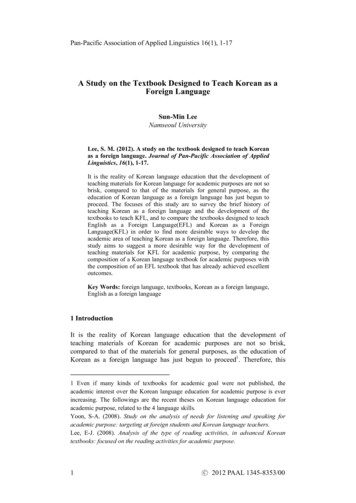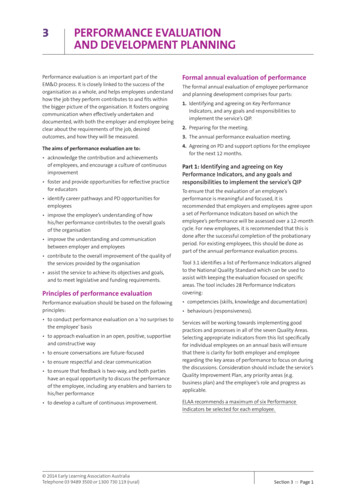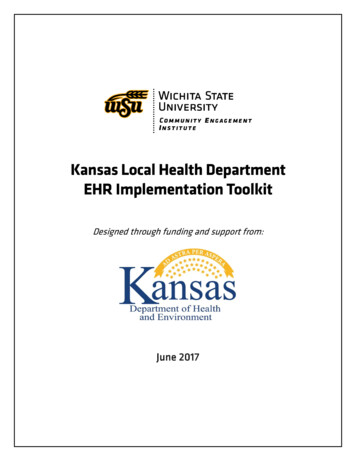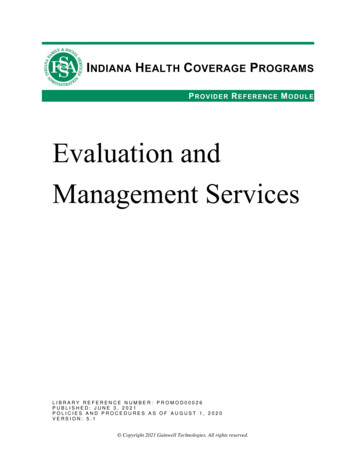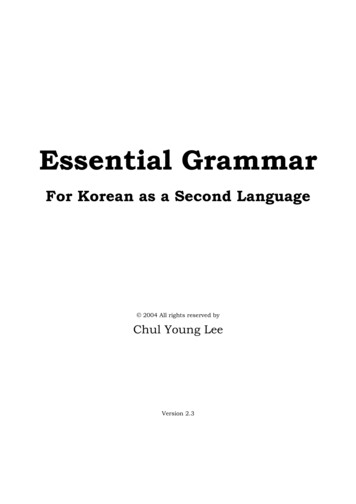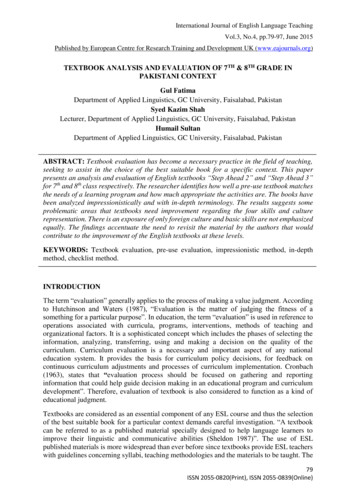
Transcription
International Journal of English Language TeachingVol.3, No.4, pp.79-97, June 2015Published by European Centre for Research Training and Development UK (www.eajournals.org)TEXTBOOK ANALYSIS AND EVALUATION OF 7TH & 8TH GRADE INPAKISTANI CONTEXTGul FatimaDepartment of Applied Linguistics, GC University, Faisalabad, PakistanSyed Kazim ShahLecturer, Department of Applied Linguistics, GC University, Faisalabad, PakistanHumail SultanDepartment of Applied Linguistics, GC University, Faisalabad, PakistanABSTRACT: Textbook evaluation has become a necessary practice in the field of teaching,seeking to assist in the choice of the best suitable book for a specific context. This paperpresents an analysis and evaluation of English textbooks “Step Ahead 2” and “Step Ahead 3”for 7th and 8th class respectively. The researcher identifies how well a pre-use textbook matchesthe needs of a learning program and how much appropriate the activities are. The books havebeen analyzed impressionistically and with in-depth terminology. The results suggests someproblematic areas that textbooks need improvement regarding the four skills and culturerepresentation. There is an exposure of only foreign culture and basic skills are not emphasizedequally. The findings accentuate the need to revisit the material by the authors that wouldcontribute to the improvement of the English textbooks at these levels.KEYWORDS: Textbook evaluation, pre-use evaluation, impressionistic method, in-depthmethod, checklist method.INTRODUCTIONThe term “evaluation” generally applies to the process of making a value judgment. Accordingto Hutchinson and Waters (1987), “Evaluation is the matter of judging the fitness of asomething for a particular purpose”. In education, the term “evaluation” is used in reference tooperations associated with curricula, programs, interventions, methods of teaching andorganizational factors. It is a sophisticated concept which includes the phases of selecting theinformation, analyzing, transferring, using and making a decision on the quality of thecurriculum. Curriculum evaluation is a necessary and important aspect of any nationaleducation system. It provides the basis for curriculum policy decisions, for feedback oncontinuous curriculum adjustments and processes of curriculum implementation. Cronbach(1963), states that “evaluation process should be focused on gathering and reportinginformation that could help guide decision making in an educational program and curriculumdevelopment”. Therefore, evaluation of textbook is also considered to function as a kind ofeducational judgment.Textbooks are considered as an essential component of any ESL course and thus the selectionof the best suitable book for a particular context demands careful investigation. “A textbookcan be referred to as a published material specially designed to help language learners toimprove their linguistic and communicative abilities (Sheldon 1987)”. The use of ESLpublished materials is more widespread than ever before since textbooks provide ESL teacherswith guidelines concerning syllabi, teaching methodologies and the materials to be taught. The79ISSN 2055-0820(Print), ISSN 2055-0839(Online)
International Journal of English Language TeachingVol.3, No.4, pp.79-97, June 2015Published by European Centre for Research Training and Development UK (www.eajournals.org)content in the textbooks should be persuasive enough to induce all the requisite skills suited toan esteemed society in the students. If the textbook is too advanced or too simple for thestudents the teacher will inevitably be faced with problems. In the selection of a textbook, it isimportant to conduct an evaluation to ensure that whether it is suitable or not. In addition tobeing a learning instrument, textbooks are also used as a supporting teaching instruments. “Thestudent’s book usually comes with other materials such as workbook, a teacher’s book or evenadditional multimodal texts for reference as a textbook package (Masuhara and Tomlinson2008)”. All these things are designed to give a cohesion to the learning and teaching and tomake it more authentic.In this study, the textbooks that have been selected for evaluation are written by two co-authorsHeather Jones and Robyn Mann and it was published in 2002. It consists of a textbook, aworkbook, and an audio CD. The authors claim that the pupil’s age, needs, interests and priorknowledge has been taken into consideration in the design and planning of the course. Theauthors also state that the activities inside the textbook are of communicative nature andencouraged learner’s autonomy and critical thinking. For the verification of their claim, achecklist has been developed for qualitative and quantitative evaluation by following McGrathterminology. Prior to the analysis of textbooks, it is necessary to conduct a preliminary analysisof the context in which the material is going to be used and a survey of the learner’s needsThe pre-use or predictive evaluation (Ellis, 1997; McGrath, 2002; Tomlinson, 2003), helps indefining which materials are best suited to the teaching purposes and learner’s needs prior toimplementation. Littlejohn (1998) observes that textbook evaluation serves the purpose ofexamining whether the methodology and content of the materials are appropriate for aparticular language teaching context. Whether they truly develop autonomy, or they trulyinvolve problem solving and if they indeed are learner centered. Therefore, in this study, thecore of systematic textbook evaluation is to examine how well a pre-use textbook matches theneeds of a learning program and how much appropriate the activities are. Needs analysis hasbeen done prior to textbook evaluation. As Hutchinson and Waters (1987: 54) point out, whatis meant by needs analysis here is ultimately the analysis of the target situation needs – the kindof language that the learners have to acquire to cope in the target situation. Tudor (1996),regarded target situation and learning needs analysis as objective and subjective needs analysisrespectively. The former collects information about the actual requirements for language useas they exist in the target situation, while the latter addresses subjective perceptions of thecourse participants about what they feel the course should be like.Although, the textbook under scope in the present study is being used in Pakistani renownedschool, pre-use analysis has been used due to limitations of the researcher to obtain informationof the actual use of the book and the way it was received by teachers and students. The pre-useanalysis would serve to examine the textbook as it is, with the content and ways of workingwhich they propose and not with what may actually happen in classrooms.LITERATURE REVIEWFredriksson and Olsson (2006), conducted a qualitative research to investigate criteria forselecting English textbooks. They investigate how English teachers in one specific uppersecondary school solve the task of selecting English textbooks. The data was collected through80ISSN 2055-0820(Print), ISSN 2055-0839(Online)
International Journal of English Language TeachingVol.3, No.4, pp.79-97, June 2015Published by European Centre for Research Training and Development UK (www.eajournals.org)interviews and in-depth study proposed by McGrath (2002). The results revealed that mostimportant criterion to consider in the selection is, according to the teachers, interesting andrelevant texts that the students can relate to. Varying and motivating texts are significant forboth teachers and students.Similarly, Perveen (2011), also conducted her study to evaluate the curriculum at the primarylevel in the light of education policies and plans in Pakistan. The article discusses the objectivesof the curriculum at the primary level and analyzes different education policies and plansregarding the achievements of objectives. Results revealed that the objectives of curriculumwere not fully achieved. The procedure of the implementation of policies and plans regardingcurriculum remained weak.Aftab et al (2014), analyzed and evaluated the textbook “Prose and Heroes” and explored thedegree it benefited both for learners and teachers. The purpose was to contribute to theimprovement of English language programs in Pakistani colleges. The study was exploratoryand descriptive in nature. For the analysis, questionnaires and semi structured interviews hadbeen used as a tool. The results revealed that relevant textbook did not cater to the needs oflearners.Hatoss (2004), presented a model which can be used for evaluating language textbooks in termsof their adequacy in teaching culture and developing intercultural skills. The model is based ontheories of culture and theories of language learning. Her model is based on three dimensions:input, method, aims. She opines that a textbook should represent the culture of the target societytoo and evaluation criteria should also focus on the cultural aspects given in the textbook.Models are necessary to provide a conceptual framework for designing a particular evaluationdepending on the specific purpose of the evaluation. “The models differ in many of their details,the decision to choose an evaluation model depends on a few important factors such as theevaluation questions, the issues that must be addressed, and the available resources (Madaus &Kellaghan, 2000).” Cunningsworth (1984), in his book ‘‘Evaluating and Selecting EFLTeaching Materials’’ also proposed a checklist of questions which summarizes the criteria forevaluation.There can be different methods of evaluation. McGrath (2002), presents some methods ofevaluation in his book ‘Materials Evaluation and Design for Language Teaching’. One of themethods he explains is the checklist method, where essential criteria are listed andsystematically checked off. Other methods are the impressionistic and in-depth method whichmeans that materials are chosen for thorough examination. McGrath (2002) recommends preuse evaluation, in-use evaluation and post-use evaluation. This means that the material shouldnot only be evaluated before being used, but constantly while using it as well as after use.McGrath’s basic explanation of textbook evaluation concerns the discovery of whether whatyou were looking for was there. When found, you then need to put a value on your findings.Evaluation implies judgment-making which therefore also means that evaluation is subjectiveTomlinson (2001), offers a short summary of the history of materials development. He givestwo reasons why the interest in materials development increased. One was the realization thatby making teachers aware of the process of materials development, it would be easier for themto understand and apply theories of language learning. It would also help teachers to developpersonally and professionally. The other reason was the understanding that no course book can81ISSN 2055-0820(Print), ISSN 2055-0839(Online)
International Journal of English Language TeachingVol.3, No.4, pp.79-97, June 2015Published by European Centre for Research Training and Development UK (www.eajournals.org)be suitable for any kind of learners. Therefore teachers need to be able to evaluate, adapt andproduce materials that would be appropriate for their particular class.Another study conducted in the Saudi Arabian context by Alamri (2008) attempted to evaluatethe quality of the sixth grade English language textbook for Saudi boys' schools which wasintroduced at the elementary stage by the Ministry of Education in 2004. A surveyquestionnaire was used in this study about the textbooks in question. The data was subjectedto analysis through descriptive statistics. The results of the study showed that there was ageneral satisfaction of teachers and supervisors concerning the book’s general appearance,design and illustrations, accompanying materials, set objectives, topic appropriateness,language components. The results also suggested that there was lack of varied and attractiveillustrations that would stimulate creativity, lack of topics which would stimulate criticalthinking.Tok (2010), studied the book “Spot on” at the primary level in Turkey. After the evaluation, heinterpreted this result that the book had some positive and negative characteristics. The goodquality of the book was that it was not about one culture. It was also helpful for teachers forhow to use. On the other hand, it also had some disadvantages that the book had not welldeveloped and interested activities. The activities did not provide helping material in achievingobjectives. It did not provide good communicative activities as well. Cakit (2006) exploredstudents and teacher’s perspectives on the textbook for ninth grade high school students. Theinvestigation reported that both groups of participants held negative notions regarding majorityof the features of the book. The most salient issues the paper proposed included the need forsimplifying reading passages in terms of vocabulary and structures, adjusting the level ofmaterials with the age of learners and taking into account different learning styles preferred bylearners.To check the extent of suitability and effectiveness of textbook, Zohrabi, et al (2012) evaluatedthe merits and demerits of English for high school freshmen in Iran from the viewpoints ofteachers and students. They focused on seven sections of layout, vocabulary, topics andcontent, exercises, skills, pronunciation, function, and social and cultural activities. The resultsof the investigation pointed out that the book was grammar oriented and more emphasis wasplaced on reading more than three other skills, insufficient practice was provided forpronunciation with respect to target culture, no social and cultural activities were included andthe layout of the book was believed to lack beauty.Another study conducted by Karatas & Fer in (2009) to evaluate English II curriculum at YTUusing Context, Input, Process and Product (CIPP) model. In this research, the data has beenanalyzed using the technique of independent samples t-test. From the responses, it wasconcluded that mostly teachers and students tend to support all four of these curriculumcomponents. However, according to the findings of the study, significant differences have beenobserved between the means of teacher’s and student’s opinions concerning certain itemsrelated with the context, input, process and product component of the curriculum. This resultindicates that while the student’s perceptions are higher, the teacher’s expectations are higherfor the items regarding the components of the curriculum. According to the findings obtainedfrom teacher’s opinions, it is essential that audio-visual materials must be varied andimplemented properly in the activities.82ISSN 2055-0820(Print), ISSN 2055-0839(Online)
International Journal of English Language TeachingVol.3, No.4, pp.79-97, June 2015Published by European Centre for Research Training and Development UK (www.eajournals.org)METHODOLOGYQuantitative and qualitative methods have been used for analyzing and evaluating the data.This section discusses design and instrument used in the study.DesignThe textbooks under study were being used by Bloomfield Hall school in Pakistan. Pre-useanalysis was used due to limitations of the researcher to obtain information of the actual use ofthe book and the way it was received by teachers and students. The pre-use analysis wouldserve to examine the textbook as it is, with the content and ways of working which they proposeand not with what may actually happen in classrooms.InstrumentsChecklists has been selected as the main instrument of the study because it offers the mosteconomical and reliable means of reaching a decision concerning the relative suitability of thetextbook under scope.The levels of analysis used in the evaluation of the textbook include two levels:Level 1: Impressionistic evaluation which involves an overall presentation and analysis of thetextbook related to its design, table of contents, distribution of units, lessons and sections in thebookLevel 2: In-depth evaluation which examines separately and more analytically the treatment ofthe different skills, reading, listening, writing and speaking and the ways of assessmentpractices provided through the book.RESULTSAnalysis of Step Ahead 2 (for 7th grade)For the analysis, the calculations have been made by using checklists. The quantitative analysisrevealed that there are 12 units in the book. Each unit is comprised of 2 lessons. The first pageof every unit presented the aims of the unit to the students. The first lesson started with alistening and reading section and then moved on to other skills. As a whole, the book has 168activities which are divided among each lesson. The activities have been given to focus variousskills. There are also four lessons other than formal learning units which represent the culturalaspects of other countries. Moreover, there was also a workbook and audio CD accompanyingthe student’s book. The formal representation of the division and percentages is given below:83ISSN 2055-0820(Print), ISSN 2055-0839(Online)
International Journal of English Language TeachingVol.3, No.4, pp.79-97, June 2015Published by European Centre for Research Training and Development UK (www.eajournals.org)Table 1. Quantitative checklist for 7th gradeImpressionistic viewTotalUnits in the bookNo. of activities in the booklessons per unitActivities per unitCultural unitsIn- Depth viewTotal activitiesActivities for Listening skillsActivities for Speaking skillsActivities for Reading skillsActivities for Writing skillsActivities for Computer skillsActivities for Thinking strategiesActivities for vocabularyActivities for grammarChapters for Culture study12222747151512124121682144Per unit1 231 22 33%The in-depth analysis of the textbook viewed that there was a difference in the percentage ofskills. The author has given more emphasis to develop writing skills among students that is25% whereas activities of grammar, vocabulary and listening skills are only 7%. Moreover, 4lessons have been given separately to familiarize the students with the foreign cultures.Figure 1. graph shows the percentage and types of exercises in the The textbook also contained sections for grammar, vocabulary, computer skills, thinkingstrategies and culture study. The graph of culture study is higher because the foreign culture84ISSN 2055-0820(Print), ISSN 2055-0839(Online)
International Journal of English Language TeachingVol.3, No.4, pp.79-97, June 2015Published by European Centre for Research Training and Development UK (www.eajournals.org)study is an additional aspect other than learning units that has been given in four sections withthe title of ‘picture study’.Analysis of listening skillsListening skill is one of the important skills of other four language skill. Step Ahead 2 hasdifferent activities on listening on different topic. Its objective is to develop the listeningcomprehension on different topics. Different purposes of listening have been given in the tablebelow:Table 2. Activities for listening skillUnitsTitleTypes of listening activitiesPage no.Unit 1Formal CorrespondenceListening for gist.5Unit 2Traditional storiesListening for comprehension.29Unit 3PlaysListening for characterization52Unit 4ManualListening for sequence86Unit 5Science fictionListening for inference114Unit 6Factual descriptionListening for fact and opinion141Unit 7journalsListening for cause and effect172Unit 8NewspapersListening to imagine195Unit 9poetryListening for key information219Unit 10 Suspense storiesListening for description249Unit 11 DocumentariesListening for analyzing a documentary277Unit 12 Persuasive magazine articleListening for persuasive technique304Analysis of Speaking skillStep Ahead 2 has following activities of speaking skill85ISSN 2055-0820(Print), ISSN 2055-0839(Online)
International Journal of English Language TeachingVol.3, No.4, pp.79-97, June 2015Published by European Centre for Research Training and Development UK (www.eajournals.org)Table 3. Categories of speaking activityCategoriesRole umentationsReciting a poemInterviewsFrequency25722211Page no.16, 6135, 96, 179, 286, 32745, 73, 105, 132, 160, 257, 319122, 310150, 200167, 209227293Percentage13%These types of speaking activities are given to learners in different topic. Its aim is to make thestudents speak confidently at different situation and express him. Discussion activity has muchfrequency rather than others. And interviews have less activity.Analysis of Reading skillDifferent activities for reading are given in the table:Table 4. Categories of reading formationalreportLiterary textExpositionPercentagefrequency1512page no.529,52,114, 172, 250, 28886142, 1962152, 21930416%Activities are functional, narrative, explanatory, informational report, literary text, expository.These activities are well organized. Comprehension questions are given to analyze the readingability of learners. These questions are according to this sequence:86ISSN 2055-0820(Print), ISSN 2055-0839(Online)
International Journal of English Language TeachingVol.3, No.4, pp.79-97, June 2015Published by European Centre for Research Training and Development UK (www.eajournals.org)Table 5. Activity for each lessonsTypes of Reading activities for each Purpose of activitylessonReading for detailsQuestionsReading for meaningsReading for ideasAnalysis of writing skillCategories of writing skills are given below in tableTable 6. Types of writing activitiesCategoriesSummaryLettersNarrativePlay WritingManualScientificFactualdescriptionEssay ntaryProposalsPersuasive textPercentageFrequency Page ,198,207,255,264,290, 29829432327%Summary writing has more activity rather than others. Aim of summary is to develop creativewriting. It is established to construct an effective and coherent text. Some activities are abovethe age of child and against the interest of the learners. These activities are proposal writing,journal writing, article writing and persuasive writing.Analysis of Vocabulary & grammarVocabulary and grammar has also an important part of language skills. It is the basic part ofstudy. These activities are those given in the table:87ISSN 2055-0820(Print), ISSN 2055-0839(Online)
International Journal of English Language TeachingVol.3, No.4, pp.79-97, June 2015Published by European Centre for Research Training and Development UK (www.eajournals.org)Table 7. Activities related to vocabulary and grammarvocabularyregisterformal & informal languagespelling rulescommonly confused wordsstory websword webssuffixes & prefixesusing a dictionaryusing a thesaurusphrasal verbshomophonestechnical wordspoetic devicessynonyms &antonymsdenotation & connotationpage 5,235256,265282languages of moviesEmotive word290309Percentage12%GrammarAdverbsprepositional phraseadjectival & adverbial phrasesContractionactive & passiveaction verbs & imperativesNounssubject & predicatePronounsreported speechConjunctionsClausesauxiliary verbsVerbsTensespage no.14,2234436094104121,131148, rcentage12%Analysis of Step Ahead 3 (for 8th grade)After an impressionistic view on the contents of the textbooks, it could be noticed that it had12 units, each consisted of two lessons. There was also a workbook and audio CDaccompanying the student’s book. The authors of the book seemed to have attempted toseparate the units of the book thematically since each unit focused on a specific topic. The firstpage of every unit presented the aims of the unit to the students. The first lesson started with alistening and reading section and then moved on to other skills. This shows the effort of theauthors to present a well-organized textbook in which the students would easily becomeaccustomed to what has been expected from each unit. The quantitative analysis of each activityhas been given in the checklist below:88ISSN 2055-0820(Print), ISSN 2055-0839(Online)
International Journal of English Language TeachingVol.3, No.4, pp.79-97, June 2015Published by European Centre for Research Training and Development UK (www.eajournals.org)Table 8. Quantitative checklist for 8th gradeImpressionistic viewUnits in the bookNo. of activities in the booklessons per unitActivities per unitCultural unitsIn- Depth viewTotal121922154Total activities Per unitPercentage%Activities for Listening skills1216%Activities for Speaking skills26213%Activities for Reading skills27214%Activities for Writing skillsActivities for Computer skillsChapters of Culture studyActivities for Thinking strategies431041231 .122%5.20%33.33%6.25%Activities for Vocabulary1216.25%Activities for Grammar1216.25%After examining the overall weighting of the sections devoted to skills in the textbook it wasconcluded that there was an imbalance between writing and the other skills (graph 2). Writingseemed to be given more importance throughout the book. Furthermore, by comparing thenumber of speaking sections to the number of listening sections and the number of writingsections to reading sections, it could be inferred that productive skills received greater attentionthan receptive skills.Figure.2. Graph Showing Percentages of Skills in the 25%6.25%6.25%5%0%89ISSN 2055-0820(Print), ISSN 2055-0839(Online)
International Journal of English Language TeachingVol.3, No.4, pp.79-97, June 2015Published by European Centre for Research Training and Development UK (www.eajournals.org)Apart from sections dedicated to basic skills, the textbook also contained sections for grammar,vocabulary, computer skills, thinking strategies and culture study. The graph of culture studyis higher because the culture study is an additional aspect other than learning units to teachforeign culture. It has been given in four sections with the title of ‘picture study’.Analysis of listening skillThe overall tasks for listening skill had variety of purposes. Each task had specific purpose forlistening. The variety of listening tasks has been given in the table.Table 9. Activities regarding listening skillsUnitsUnit 1Unit 2TitleTypes of listening activitiesPage no.Forms and SurveysListening for information4Contemporary realistic short Listening for sequence and character 24storiesdescriptionUnit 3 Informative textsListening for cause and effect51Unit 4 Informative brochuresListening for advice80Unit 5 Formal lettersListening for purpose106Unit 6 RecountsListening for chronological order129Unit 7 ReviewsListening for reason158Unit 8 Interviews and transcriptsListening for information180Unit 9 Patriotic lyrics and inspirational Listening to interpret imaginary200poetryUnit 10 ArgumentsListening for arguments225Unit 11 Persuasive brochuresListening for persuasive message250Unit 12 Film studyListening for analyzing movie275Table shows that each lesson has specific task for listening according to the topic or theme ofthat lesson. The purpose is to make the students able to interpret the utterances in differentcontexts. The percentage of this activity in the book is only 6%.Analysis of Speaking skillSpeaking skill is further divided into five categories in the book. The versatility of speakingskill is given below with the frequency:Table 10. Categories of speaking skillCategoriesRole tageFrequency44710113%Page no.42, 231, 241, 258136, 153, 219, 29731, 59, 75, 86, 164, 205, 27910, 17, 68, 111, 119, 146, 193, 213, 233, 26718590ISSN 2055-0820(Print), ISSN 2055-0839(Online)
International Journal of English Language TeachingVol.3, No.4, pp.79-97, June 2015Published by European Centre for Research Training and Development UK (www.eajournals.org)It can be seen that discussion and presentation methodology have high frequency in the bookwhich means that these are most authentic and effective ways of improving speaking skill. Asa whole, the percentage of this activity is 13%Analysis of Reading skillTexts types for reading are of different nature. Categorization and frequency is given below:Table 11. categories of reading skillCategories of textsInformation reportShort functional textFactual recountNarrativeExpositionFrequency of reading categories24132Percentage14%Frequency of short functional text is more than others. This type of texts are used to familiarizewith surveys and forms, formal letters, brochures, interviews, questionnaires, transcripts etc.Its frequency is 14% which is little more than speaking skill.Table 12. Activity for each lessonTypesofReading Purpose of activityactivities for each lessonReading for detailsQuestionsReading for meaningsReading for ideasQuestions are given at the end of each lesson that can only be answered by close reading. Thequestions are asked from three different perspectives to check the understanding of thestudents.Analysis of Writing skillWriting skill has further typologies. Each has its own way and rules. Each unit has a writingworkshop as well which guides how to write in particular context. These typologies are givenwith frequencies in table below:91ISSN 2055-0820(Print), ISSN 2055-0839(Online)
International Journal of English Language TeachingVol.3, No.4, pp.79-97, June 2015Published by European Centre for Research Training and Development UK (www.eajournals.org)Table 13. Types of writing activitiesTypes of writing activitiesExpo
evaluation in his book ‘Materials Evaluation and Design for Language Teaching’. One of the methods he explains is the checklist method, where essential criteria are listed and systematically checked off. Other methods are the impressionistic and in-depth method which




